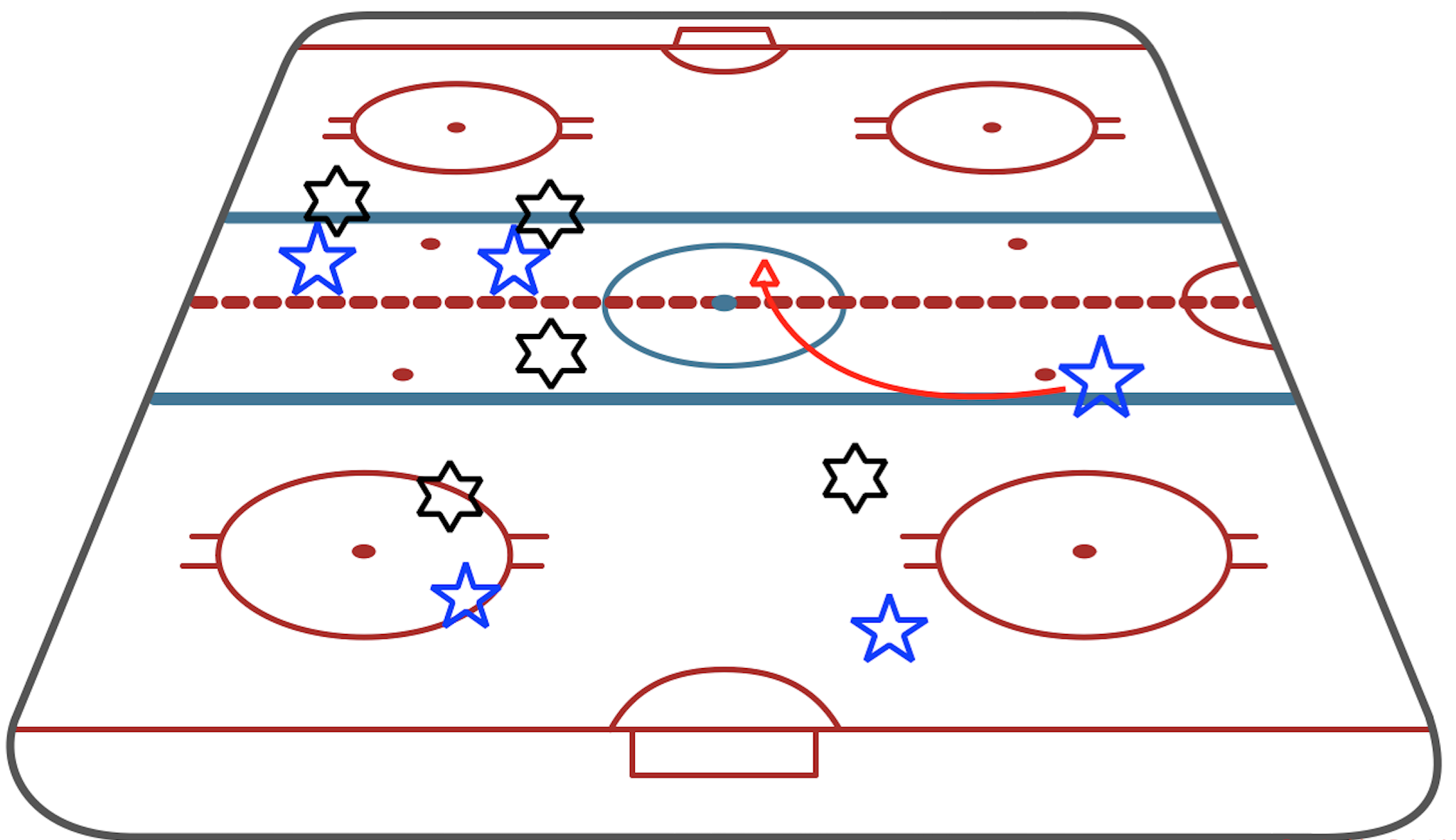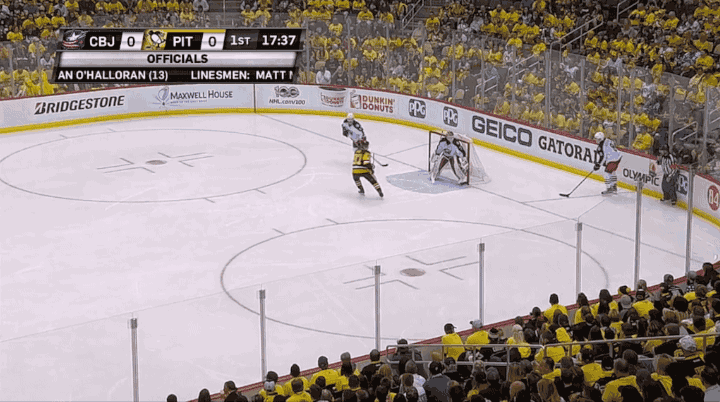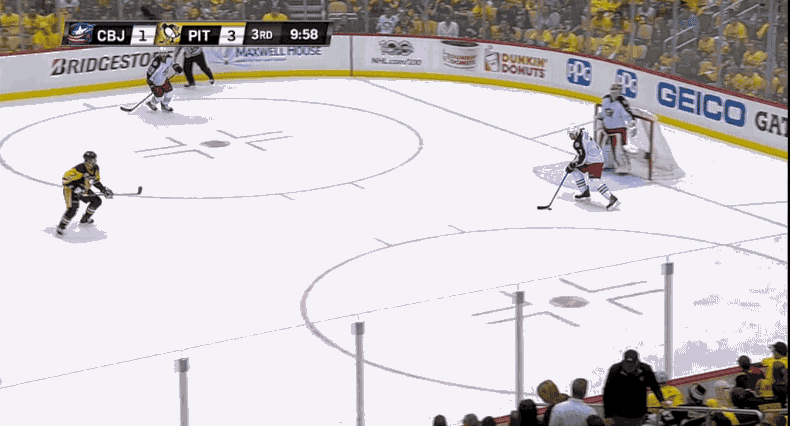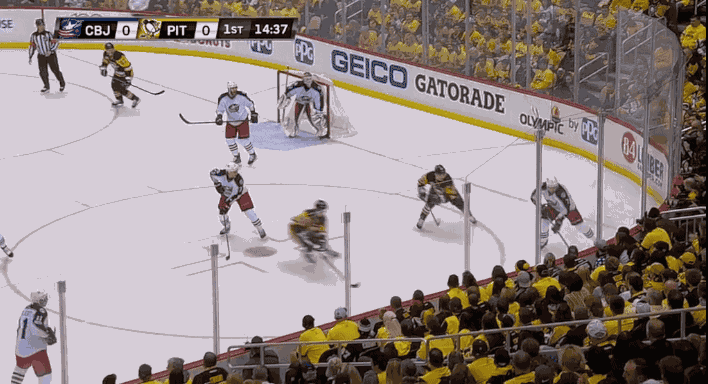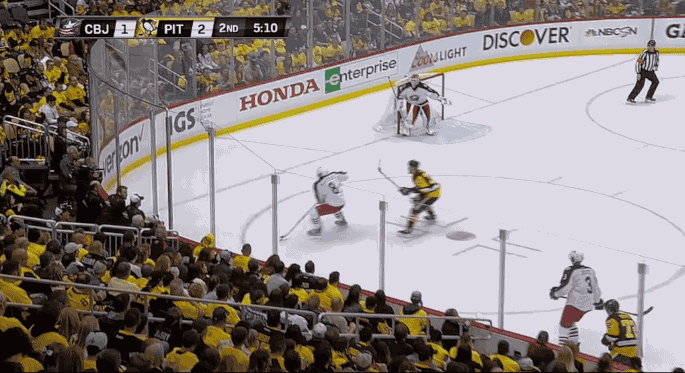Before this series started, we talked about the Penguins forecheck and how the Blue Jackets would handle the two man front the Penguins were likely to send at them during their defensive zone breakouts.
Through the first two games of this first round series, the Penguins aggressive front has driven a wedge between the Columbus defense and its forwards waiting up ice to retrieve outlet passes.
When a team is starting the play from deep in its own zone, it’s defensemen are the life-support of the breakout. They’re surveying the ice, either taking whats given to them and opting to skate the puck out of danger or making outlet passes that enable their forwards to enter the offensive zone in advantageous situations.
The Penguins forechecking structure has cut that life-support from the Blue Jackets forwards.
Instead of the Jackets being able to work the puck up ice to its forwards in puck-support situations, its defensemen are tossing the puck up ice into a chaotic mess of bodies. The Penguins are forcing the Blue Jackets into making stretch passes into areas of the ice where they hold a man-power advantage.
Period by period, this structure has disrupted the Jackets ability to jump start the play and control the neutral-zone. Before we jump into video, let’s take a look at how this approach manifests itself on paper.
Columbus likes to run two wingers up ice in tandem, with a third swinging into the play once the breakout gets rolling. The Penguins would typically roll out in a 1-2-2 forecheck that sends a single forward up ice to pressure the opposing teams defense, but because of the Jackets ability to swing a late man into the middle of the ice, that 1-2-2 can be exploited, as the swinging wing can fit directly into the center of the Penguins trap with enough time and space to be problematic.
This is extremely similar to the problems the Tampa Bay Lightning created for the Penguins last season in the Eastern Conference Final. It wasn’t until Game 6 that the Penguins adjusted and adopted the strategy you see in the above image. They won the next two games and successfully employed this forecheck en route to the Stanley Cup.
What the Penguins have done here is created a desert between the Columbus defense and its forwards. The defenders don’t have room to skate because of the pressure applied by the Penguins forecheck. Their breakouts generally take longer, which means their forwards drift up ice getting further and further away from the point of the breakout pass. In addition to that issue, they’re drifting directly into a mess of black and gold jerseys that are ready to disrupt these breakout attempts and turn the play the other way.
Let’s take a look at how this manifests itself in video from last night’s 4-1 victory:
The Penguins apply two forecheckers to the top of this play providing a bit of token pressure against the Columbus defense. This token pressure is enough to prevent the Columbus defense from making sound decisions with their outlets. You can see the indecision here in the clip. The defenseman wants to hit the swinging winger with an early pass, put its cut off. He wants to defer to his partner, but there’s a forechecker in that area as well. He opts for a long puck pass that crosses two lines into a mess of bodies in the neutral zone. The play is immediately broken up.
Here’s another great view of this approach in action:
In this clip, the Penguins once again have two forecheckers shadowing the Columbus defense. This time, Columbus elects to take the D-to-D pass, but Bryan Rust is immediately on top of his assignment and is able to force a bad decision. It doesn’t appear that either one of these defensemen want the puck. That’s how uncomfortable the Penguins can make other teams. The puck is immediately turned over on outlet and the Penguins head off to the races the other way with numbers.
When we talk about the speed of the Penguins, this is one of the things we’re talking about. They have the ability to be everywhere at once. They can cover such a large amount of ice with their foot speed that they can create an illusion of availability where none exists.
Obviously, these examples are on controlled breakouts. But the Penguins double pressure exists on every type of zone exit attempt you can draw up. Let’s take a look at some examples that are a bit more transition based and less structured than the clips we just examined.
In this clip, we see a Columbus defenseman trying to play a touch pass up the boards to a teammate to get possession of the puck. This ends up harmlessly trickling through the neutral zone. Notice how the Penguins immediately swarm the defenseman attempting to outlet the puck.
We’ll see that theme in the clip below, as Columbus once again finds itself frustrated by this constant pressure.
In this clip, the Columbus defender tries to take the initiative to skate away from the Penguins forecheck, instead, he’s immediately pressured by Carter Rowney and Patric Hornqvist, working together as a tandem.
Once it becomes clear that this breakout attempt will fail, Matt Cullen pounces into the play and provides additional puck support for his teammates. At every exit point for the Jackets, if the Penguins can get two players there, they will.
We’ve heard the word attrition tossed around a lot this series, mostly in conjunction with the hit totals boasted by Columbus. For me, attrition manifests itself as trying to deal with this type of persistent pressure by the Penguins shift after shift.
Columbus is heading home staring down the face of a 2-0 series deficit. Their actions at the end of Game 2, namely Matt Calvert’s assault on Tom Kuhnhackl, indicate that they’re running out of ideas when it comes to handling the pressure and the speed of the Penguins forecheck. If they can’t solve for this issue, that frustration will ultimately cost them.
Add The Sports Daily to your Google News Feed!

